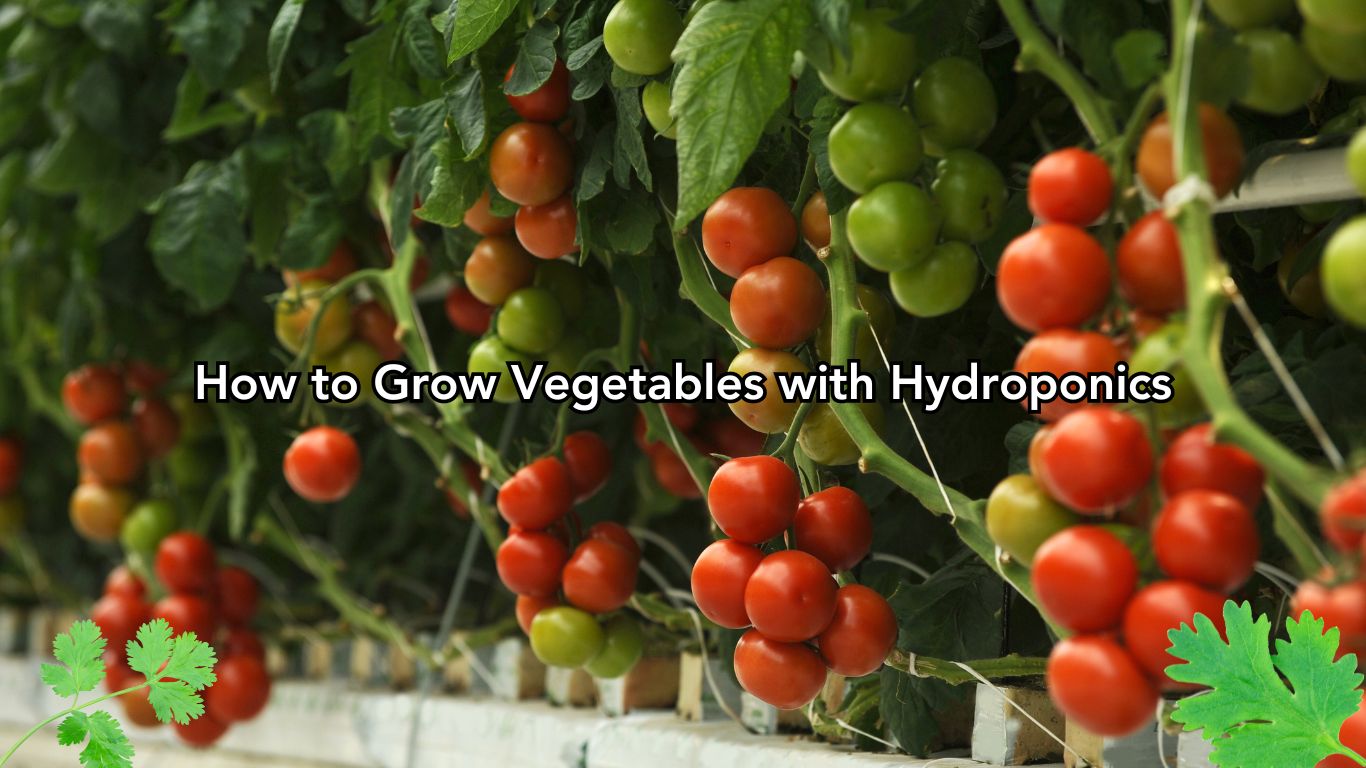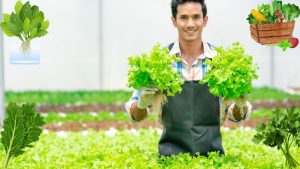How to Grow Vegetables with Hydroponics

Growing your vegetables is a rewarding and sustainable way to produce fresh, healthy food, but for many gardeners, the limitations of outdoor gardening—such as climate, space, and seasonal changes—can make it a challenge. However, there’s a solution that allows you to grow vegetables year-round, regardless of the weather: hydroponics. In this article, we will explore how to grow vegetables with hydroponics, the different systems available, the benefits, and how to get started in this fascinating and eco-friendly gardening method.
What is Hydroponics?
Hydroponics is a method of growing plants without soil, using a nutrient-rich water solution that directly supplies the plants with essential nutrients. By eliminating soil, hydroponics provides a cleaner and more efficient environment for plants, allowing them to grow faster and healthier. This technique can be used indoors or outdoors and is particularly effective for growing vegetables in places where soil quality is poor, or the growing season is short.
How to Grow Vegetables with Hydroponics
Hydroponic systems come in various forms, but they all share the same basic principle: the plant roots are suspended in a water solution or substrate, allowing them to access nutrients, oxygen, and water more effectively than traditional soil methods. Understanding how to grow vegetables with hydroponics can open up a world of possibilities for fresh produce right at home.

Why Choose Hydroponics for Growing Vegetables?
One of the most compelling reasons to learn how to grow vegetables with hydroponics is the ability to control the growing environment completely. Unlike traditional gardening, which is influenced by soil quality, pests, and weather, hydroponic systems allow you to provide plants with the perfect balance of nutrients, light, and water. This controlled environment leads to several significant advantages:
- Faster Growth: Plants grown hydroponically grow up to 50% faster than those grown in soil, thanks to the direct access to nutrients.
- Year-Round Growing: Indoor hydroponic systems enable you to grow vegetables regardless of the season or climate, making it possible to enjoy fresh produce all year long.
- Space-Efficient: Hydroponic systems are ideal for urban gardeners with limited space. Vertical systems, such as tower gardens, allow you to grow more plants in a smaller footprint.
- Water Efficiency: Hydroponics uses less water than traditional gardening, as the water is recirculated in a closed system rather than being absorbed into the soil.
- No Soil-Borne Diseases: Since hydroponics does not use soil, many common soil-borne diseases and pests are eliminated, making it a cleaner and more efficient method of gardening.
Different Types of Hydroponic Systems
Before diving into how to grow vegetables with hydroponics, it’s essential to understand the different systems available. Each system has its advantages, and the best one for you depends on your space, budget, and the type of vegetables you want to grow.
1. Deep Water Culture (DWC)
Deep Water Culture is one of the simplest hydroponic systems. Plants are suspended with their roots submerged in nutrient-rich water, which is oxygenated by an air pump. This system is excellent for beginners due to its simplicity and affordability.
Best for: Leafy greens like lettuce, spinach, and herbs.
2. Nutrient Film Technique (NFT)
In the Nutrient Film Technique, a thin film of nutrient solution flows through a sloped channel, with the plant roots partially exposed to the solution. The continuous flow ensures that the plants receive oxygen and nutrients consistently.
Best for: Lettuce, strawberries, and other small, lightweight plants.
3. Ebb and Flow (Flood and Drain)
In the Ebb and Flow system, plants are temporarily flooded with nutrient solution before it drains back into the reservoir. This intermittent flooding provides plants with the nutrients they need while also allowing the roots to receive oxygen.
Best for: Vegetables like tomatoes, cucumbers, and bell peppers.
4. Aeroponics
Aeroponics involves suspending plant roots in the air and misting them with a nutrient solution. This system is incredibly efficient in terms of water and nutrient use, but it requires more maintenance and can be more expensive than other systems.
Best for: A wide range of vegetables, especially herbs and leafy greens.
5. Drip Systems
In a drip system, a slow drip of nutrient solution is delivered to the base of each plant. Excess water is collected and recirculated back into the system. This is a highly efficient system but can require more setup than simpler methods like DWC.
Best for: Large plants like tomatoes, peppers, and eggplants.
![]()
How to Grow Vegetables with Hydroponics: Step-by-Step Guide
Now that you have a basic understanding of hydroponic systems, let’s look at the steps involved in how to grow vegetables with hydroponics successfully.
1. Choose Your System
Select a hydroponic system based on the type of vegetables you want to grow, your available space, and your budget. For beginners, Deep Water Culture or an NFT system is a good choice due to its simplicity and effectiveness.
2. Select Your Vegetables
Not all vegetables thrive in hydroponic systems, but many do. The best vegetables to grow in hydroponics include:
- Lettuce
- Spinach
- Kale
- Basil
- Cucumbers
- Tomatoes
- Peppers
- Strawberries
Root vegetables like carrots and potatoes don’t grow well in hydroponic systems, as they require more space to develop underground.
3. Prepare Your Setup
Ensure you have all the necessary equipment, including a reservoir, air pump, growing medium, grow lights (if growing indoors), and a nutrient solution. The growing medium can include rock wool, perlite, or coconut coir, depending on your system.
4. Start Your Seeds
Germinate your seeds in a separate seedling tray or directly in your hydroponic system, depending on your setup. Ensure the seeds are kept in a warm, humid environment until they sprout.
5. Transplant to the Hydroponic System
Once your seedlings have grown a few inches, transfer them to your hydroponic system. Make sure the roots have adequate access to the nutrient solution and that the plants receive enough light, either from natural sunlight or grow lights.
6. Maintain Your System
The key to how to grow vegetables with hydroponics successfully lies in maintaining the proper nutrient balance, light exposure, and water levels. Monitor your pH regularly to ensure the plants are receiving the optimal conditions for growth. You may need to adjust the nutrient solution every 1-2 weeks and top off the water as needed.
7. Harvest Your Vegetables
One of the joys of hydroponic gardening is the faster growth rate, meaning you’ll be able to harvest your vegetables sooner than with traditional gardening. For continuous harvests, plant new seeds as you harvest mature plants.
![]()
Common Challenges in Hydroponic Gardening
Learning how to grow vegetables with hydroponics can be highly rewarding, but there are a few challenges to be aware of:
- Nutrient Imbalances: Overfeeding or underfeeding your plants can lead to nutrient deficiencies or toxicities. Regularly monitor the nutrient solution and adjust as necessary.
- Algae Growth: Algae can grow in your system if light reaches the water reservoir. Cover your reservoir or use opaque containers to prevent this.
- pH Fluctuations: The pH of your water can affect nutrient uptake. Keep it in the optimal range of 5.5 to 6.5 for most vegetables.
Frequently Asked Questions (FAQs)
1. Can you grow root vegetables with hydroponics?
Most root vegetables like carrots and potatoes are not well-suited to hydroponics due to their need for space to expand underground. However, some shallow-rooted vegetables like radishes can be grown successfully in hydroponic systems.
2. How much light do hydroponic vegetables need?
If you are growing your vegetables indoors, they will need approximately 12-16 hours of light per day. LED grow lights are an excellent choice for providing the necessary light spectrum without consuming too much electricity.
3. How often should I check my nutrient solution?
It’s a good idea to check the nutrient solution once a week. Look at the water level, pH, and nutrient concentration. Adjust the nutrient mix as needed to keep your plants healthy.
4. Do I need to pollinate my hydroponic plants?
If you are growing plants that produce fruit (like tomatoes or peppers) indoors, you may need to hand-pollinate them, as there will be no natural pollinators like bees in your indoor environment.
5. What are the startup costs for hydroponic gardening?
The cost of setting up a hydroponic system varies depending on the size and type of system. A small DIY system may cost around $100, while a larger, more complex setup with grow lights and automated systems can run into several hundred dollars.
Conclusion
Understanding how to grow vegetables with hydroponics opens up a new world of gardening possibilities. Whether you live in an apartment with limited outdoor space, face harsh winter conditions, or simply want to grow fresh vegetables year-round, hydroponics provides an efficient and sustainable solution. With the right setup and a little care, you can enjoy healthy, homegrown vegetables from your own hydroponic garden. Happy growing!

3 Comments